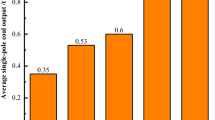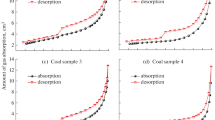Abstract
Coalbed methane is a risk of coal mining safety while being an important energy source, and gas extraction is the most effective treatment method. However, roadway and borehole surrounding rock fracture lead to air leakage and thus reduce gas extraction efficiency. To determinate the surrounding rock fracture zone and improve the borehole sealing effect, this work proposed a new method based on constant-pressure gas injection. The feasibility of this method is validated by combining theoretical analysis, numerical simulation and field tests. Results showed that: (1) as the drilling depth grew from 5 to 13 m, the injected-gas flow rate dropped quickly from 41.2 to 10.0 L/min, and then fluctuated slightly to 11.7 L/min, obtaining the minimum flow rate at 9 m, which indicated that the width of the roadway surrounding rock fracture zone was 9 m. (2) The mathematical model of coal stress, permeability and damage evolution were built to describe the gas flow during the gas injection in different borehole depths. The numerical simulation reflects that the injected gas mainly leaks through walls of the roadway rather than along the borehole, with the former being 6.5 times of the latter. (3) The gas extraction concentration increased from about 20% to more than 30% when the sealing depth grew from 8 to 10 m, which indicated the sealing depth of gas extraction boreholes shall be slightly larger than 9 m. This proves that the constant-pressure gas injection method can offer effective references in determining the roadway surrounding rock fracture zone and gas extraction boreholes sealing depth.
Highlights
-
A new method for determining the sealing depth based on the constant-pressure gas injection was proposed.
-
The mathematical model of coal stress, permeability and damage evolution was built.
-
The leakage characteristics during gas injection in borehole were investigated.
















Similar content being viewed by others
Data availability
The data used to support the findings of this study are included within the article.
References
Aydin G (2014) Production modeling in the oil and natural gas industry: An application of trend analysis. Pet Sci Technol 32(5):555–564
Aydin G (2015) Forecasting natural gas production using various regression models. Pet Sci Technol 33(15–16):1486–1492
Aydin G, Karakurt I, Aydiner K (2012) Analysis and mitigation opportunities of methane emissions from energy sector. Energy Sources Part a Recov Utili Environ Effects 34(11):967–982
Azadeh A, Tarverdian S (2007) Integration of genetic algorithm, computer simulation and design of experiments for forecasting electrical energy consumption. Energy Policy 35(10):5229–5241
Chen D, Pan ZJ, Shi JQ et al (2016) A novel approach for modelling coal permeability during transition from elastic to post-failure state using a modified logistic growth function. Int J Coal Geol 163:132–139
Danesh NN, Chen ZW, Aminossadati SM et al (2016) Impact of creep on the evolution of coal permeability and gas drainage performance. J Nat Gas Sci Eng 33:469–482
Frid V (1997) Rockburst hazard forecast by electromagnetic radiation excited by rock fracture. Rock Mech Rock Eng 30(4):229–236
He J, Dong KY (2014) Research on rational sealing depth of gas drainage borehole in large section roadway. China Coal 40(2):101–104
Hou CJ, Ma NJ (1989) ) Discussion on coal stress and ultimate balance area on two sides of roadways. J China Coal Soc 4:21–29
Jiang JY, Lu WY (2013) Study on the reasonable sealing depth of gas drainage drilling in coal seam. Shanxi Coking Coal Sci Technol 37(11):24–27
Li BZ, Sun CX (2012) Determination of reasonable hole sealing depth in gas suction drilling. Jiangxi Coal Sci Technol 30(6):298–300
Lin BQ, Shen CM (2015) Coal permeability-improving mechanism of multilevel slotting by water jet and application in coal mine gas extraction. Environ Earth Sci 73(10):5975–5986
Liu QQ, Cheng YP, Yuan L et al (2014) A new effective method and new materials for high sealing performance of cross-measure CMM drainage boreholes. J Nat Gas Sci Eng 21:805–813
Liu QQ, Zhou HX, Cheng YP et al (2018) An improved method for high-efficiency coal mine methane drainage: Theoretical analysis and field verification. Energy Sci Eng 6(6):739–748
Lu SQ, Cheng YP, Ma JM et al (2014) Application of in-seam directional drilling technology for gas drainage with benefits to gas outburst control and greenhouse gas reductions in Daning coal mine. China Natural Hazards 73(3):1419–1437
Ma D, Rezania M, Yu HS et al (2017) Variations of hydraulic properties of granular sandstones during water inrush: effect of small particle migration. Eng Geol 217:61–70
Ma D, Duan HY, Li XB et al (2019) Effects of seepage-induced erosion on nonlinear hydraulic properties of broken red sandstones. Tunnel Undergr Sp Technol 91:102993
Morad K (2012) Selected topics in coalbed methane reservoirs. J Nat Gas Sci Eng 8:99–105
Si GY, Jamnikar S, Lazar J et al (2015a) Monitoring and modelling of gas dynamics in multi-level longwall top coal caving of ultra-thick coal seams, part I: borehole measurements and a conceptual model for gas emission zones. Int J Coal Geol 144–145:98–110
Si GY, Jamnikar S, Lazar J et al (2015b) Monitoring and modelling of gas dynamics in multi-level longwall top coal caving of ultra-thick coal seams. Part II: numerical modelling. Int J Coal Geol 144–145:58–70
Si LL, Wei JP, Xi YJ et al (2021a) The influence of long-time water intrusion on the mineral and pore structure of coal. Fuel 290:119848
Si LL, Zhang HT, Wei JP et al (2021b) Modeling and experiment for effective diffusion coefficient of gas in water-saturated coal. Fuel 284:118887
Tao M, Hong ZX, Peng K et al (2019) Evaluation of excavation-damaged zone around underground tunnels by theoretical calculation and field test methods. Energies 12(9):1682–1700
Wang L, Cheng YP (2012) Drainage and utilization of Chinese coal mine methane with a coal-methane co-exploitation model: Analysis and projections. Resour Policy 37(3):315–321
Wang EY, He XQ (2000) An experimental study of the electromagnetic emission during the deformation and fracture of coal or rock. Chin J Geophys 43(1):131–137
Wang L, Cheng YP, An FH et al (2014) Characteristics of gas disaster in the Huaibei coalfield and its control and development technologies. Nat Hazards 71(1):85–107
Wang HW, Jiang YD, Xue S et al (2015a) Assessment of excavation damaged zone around roadways under dynamic pressure induced by an active mining process. Int J Rock Mech Min Sci 77:265–277
Wang ZF, Zhou Y, Sun YN et al (2015b) Novel gas extraction borehole grouting sealing method and sealing mechanism. J China Coal Soc 40(3):588–595
Wang ZM, Sun YN, Wang YL et al (2019) A coupled model of air leakage in gas drainage and an active support sealing method for improving drainage performance. Fuel 237:1217–1227
Wei FQ, Lian SP, Zhang C et al (2013) Study on reasonable hole-sealing-depth down the seam of Mengjin mine. J Henan Polytech Univ (natural Science) 32(6):686–690
Wei JP, Wei ZH, Wang DK, et al (2015) System and method for measuring fracture width of coal seam roadway based on gas leakage of borehole. China
Xia TQ, Zhou FB, Liu JS et al (2014) A fully coupled coal deformation and compositional flow model for the control of the pre-mining coal seam gas extraction. Int J Rock Mech Min Sci 72:138–148
Xiao WJ, Zhang DM, Wang XJ (2020) Experimental study on progressive failure process and permeability characteristics of red sandstone under seepage pressure. Eng Geol 265(C):1–11
Xu Z, Luo DK (2018) Forecasting fossil energy consumption structure toward low-carbon and sustainable economy in China: evidence and policy responses. Energ Strat Rev 22:303–312
Xu JZ, Zhai C, Liu SM et al (2017) Feasibility investigation of cryogenic effect from liquid carbon dioxide multi cycle fracturing technology in coalbed methane recovery. Fuel 206:371–380
Xu PP, Zhang QY, Qian H et al (2021) Microstructure and permeability evolution of remolded loess with different dry densities under saturated seepage. Eng Geol 282:1–14
Xue Y, Gao F, Gao YN et al (2016) Quantitative evaluation of stress-relief and permeability-increasing effects of overlying coal seams for coal mine methane drainage in Wulan coal mine. J Nat Gas Sci Eng 32:122–137
Zhang K, Sun K, Yu BY et al (2016) Determination of sealing depth of in-seam boreholes for seam gas drainage based on drilling process of a drifter. Eng Geol 210:115–123
Zhang JG, Zhai C, Zhong C et al (2019) Investigation of sealing mechanism and field application of upward borehole self-sealing technology using drill cuttings for safe mining. Saf Sci 115:141–153
Zhao D, Pan JT (2018) Numerical simulation on reasonable hole-sealing depth of boreholes for gas extraction. AIP Adv 8(4):1–17
Zheng CS, Mehmet K, Chen ZW et al (2017) Effects of coal damage on permeability and gas drainage performance. Int J Min Sci Technol 27(5):783–786
Zhou FB, Xia TQ, Wang XX et al (2016) Recent developments in coal mine methane extraction and utilization in China: a review. J Nat Gas Sci Eng 31:437–458
Acknowledgements
This project is supported by the Natural Science Foundation of Henan(202300410182), National Natural Science Foundation of China(51974109, 52004083, 52174073), the Scientific and Technological Projects of Henan Province (202102310220), the Plan of Key Scientific Research Projects of Colleges and Universities in Henan Province (20A620001).
Author information
Authors and Affiliations
Corresponding author
Ethics declarations
Conflicts of interest
The authors declare that they have no conflicts of interest.
Additional information
Publisher's Note
Springer Nature remains neutral with regard to jurisdictional claims in published maps and institutional affiliations.
Rights and permissions
About this article
Cite this article
Yao, B., Yao, S., Wei, J. et al. A New Method for Determining the Sealing Depth of Extraction Borehole Based on the Constant-Pressure Gas Injection and its Applications. Rock Mech Rock Eng 55, 3703–3717 (2022). https://doi.org/10.1007/s00603-022-02844-5
Received:
Accepted:
Published:
Issue Date:
DOI: https://doi.org/10.1007/s00603-022-02844-5




